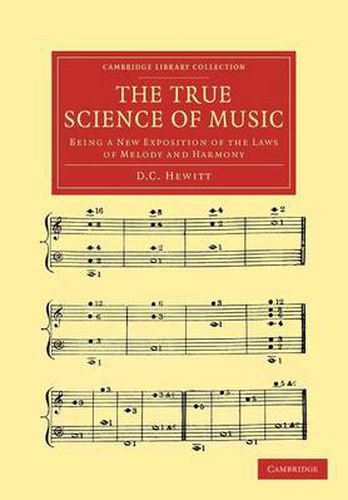Readings Newsletter
Become a Readings Member to make your shopping experience even easier.
Sign in or sign up for free!
You’re not far away from qualifying for FREE standard shipping within Australia
You’ve qualified for FREE standard shipping within Australia
The cart is loading…






The physics of music has fascinated scholars and scientists since ancient times, from Pythagoras’ concept of celestial harmony, to the work of Galileo, Mersenne, Euler and Ohm, culminating in the nineteenth century in Helmholtz’s definitive work, On the Sensations of Tone. Daniel Chandler Hewitt (1789-1869) was a piano maker who also devised improvements to the seraphine (a form of reed organ). This idiosyncratic work, first published in 1864, only a year after Helmholtz’s German text (also reissued in this series in the 1875 English translation), discusses the mathematics of musical intervals according to Hewitt’s ‘Triune’, or three-fold, system of calculation using his Musical Ratiometer (included at the end of the volume). Musical examples, gathered at the end of the work, illustrate his arguments and include a close analysis of the intervals and chord structures of the Moonlight and the Appassionata piano sonatas by Beethoven.
$9.00 standard shipping within Australia
FREE standard shipping within Australia for orders over $100.00
Express & International shipping calculated at checkout
The physics of music has fascinated scholars and scientists since ancient times, from Pythagoras’ concept of celestial harmony, to the work of Galileo, Mersenne, Euler and Ohm, culminating in the nineteenth century in Helmholtz’s definitive work, On the Sensations of Tone. Daniel Chandler Hewitt (1789-1869) was a piano maker who also devised improvements to the seraphine (a form of reed organ). This idiosyncratic work, first published in 1864, only a year after Helmholtz’s German text (also reissued in this series in the 1875 English translation), discusses the mathematics of musical intervals according to Hewitt’s ‘Triune’, or three-fold, system of calculation using his Musical Ratiometer (included at the end of the volume). Musical examples, gathered at the end of the work, illustrate his arguments and include a close analysis of the intervals and chord structures of the Moonlight and the Appassionata piano sonatas by Beethoven.